How has agriculture in the American Midwest evolved over time?
For thousands of years, Iowa’s rich soil has supported many different people who have called "the land between two rivers" home. Native American women planted corn, beans and squash in carefully cultivated gardens along Iowa’s rivers. When the sweet corn ripened in early August, the tribe celebrated. For the Meskwaki in Tama County, it was called the “the Green Corn Dance” and later became the starting point for the tribe’s famous pow wow.
Iowa's First Settlers Profit from Farmland
The eastern United States is mostly covered in forests. Pioneers moving westward knew how to carve out farms among the trees but did not have experience on the treeless Iowa prairies which covered 85 percent of central and western Iowa. They needed to learn how to plow up for the first time the tough roots that held the soil in place. The first settlers often planted wheat as their primary cash crop but discovered that corn was more profitable. While it was hard to market bulky wagon loads of grain, corn could be fed to hogs which could be driven to markets or butchered in the winter and transported frozen on sleds. Meat brought a better price than the grain itself.
In the second half of the 19th century, 1850 to 1900, Iowa farmers experience the rural side of the Industrial Revolution. John Deere, an Illinois blacksmith, invented a steel plow that would clean off the sticky prairie soil, unlike earlier iron plows that clogged and had to be scraped frequently. Horses replaced oxen as a source of power with the invention of new machinery. Hay rakes, mowers, corn planters and multi-row plows allowed one farmer to cultivate more acres than ever before. Production skyrocketed. When barbed wire allowed farmers to keep their animals contained, they began to import purebred livestock from Europe. They held fairs to compare their efforts in quality seed and animals. Refrigerated railroad cars permitted beef and pork to be slaughtered in Iowa and shipped to the growing cities of the east.
Science Propels Agricultural Practices Forward
After WWI (1917-1918), the gasoline engine began to make its way onto the farm to replace horses as the primary source of power. Tractors did not need to be fed when they were not working nor did farms have to devote fields to the cultivation of oats. Tractors came in larger and larger sizes and could plow and harvest fields much faster than horses could. At the same time, scientists began to promote the advantages of hybrid seed to produce bigger and better crops. Iowa-born Henry Wallace, later to become secretary of agriculture and vice president, was a co-founder of Pioneer Hybrid Seed that helped boost corn production across the Midwest. Iowa State University was a leader in the development of herbicides, pesticides and fertilizers and teaching farmers how to use them that also contributed to a major boost in Iowa farm production. The ISU Extension Service placed a farm specialist and home economist in every Iowa county to make the entire state a classroom and to improve farm life.
Beginning in the 1960s, science jumped to a new level with new discoveries in genetics. Until then, farming had always been about improving the surroundings in which a plant grew — insuring adequate sunlight and water, eliminating weeds and improving the quality of the soil. Genetic engineering was something new. It went into the plant itself and gave it new directions on how to grow and to resist disease. Iowa’s Norman Borlaug took the new agriculture improvements to impoverished nations around the world. He was a leader of what has been called “the Green Revolution” to increase the world’s food supply. His work is estimated to have saved the lives of one billion people from starvation. In 1970, he was awarded the Nobel Peace Prize.
Farm Families Decline in the Late 20th, Early 21st Century
Agriculture has faced many problems with these new developments. In the 20th century, 1900 to 1999, farmers could often produce more than the market could sell at a satisfactory price, and surpluses developed. When prices plunged as a result, farmers planted even more to maintain their incomes, creating even bigger surpluses. The federal government in the 1930s instituted programs to try to keep up prices for those farmers that would agree to reduce their production. In both WWI and WWII, farmers were encouraged to produce as much as they could to support the U.S. and its allies. Adjusting to peacetime created problems both times in the post-war world. Demand for farm products was strong in the 1970s, and once again, farmers geared up for top production. They borrowed money to buy larger equipment and paid more money to buy more land. In 1980, farm and farmland prices collapsed suddenly and many farmers could not meet their financial obligations. Many of them lost their farms. The small-town banks around the state that had lent them money also felt hard times. Many of them filed for bankruptcy. Merchants in small towns saw their sales drop, and many were forced to close their doors. The early years of the 1980s were called the "Farm Crisis," the worst times Iowa had experienced since the Great Depression of the 1930s.
Since the first wave of new machinery in the late 1800s, farms have grown in size and the number of farms has decreased. Many rural Iowa counties had their highest population figures in the early 20th century, and have witnessed a gradual decline ever since. Losing students, rural schools were forced to consolidate into larger districts. Farm representation in the Iowa Legislature, once dominating everything else, was forced to yield seats to the growing urban cities.
On the other hand, the growth in numbers of families living in the country who are not farmers has grown. With good roads, cities now attract daily commuters from surrounding counties and beyond, blurring the lines between urban and rural. By any measure, however, Iowa agriculture is a power force in the economy and in the source of food for a hungry world.
Supporting Questions
How has farming in the American Midwest changed over time?
- Letter from Giles S. Thomas to his Family, July 23, 1876 (Document)
- "The Crop Outlook" Newspaper Article, June 30, 1906 (Document)
- "1913 Farm Crops and their Value" Newspaper Article, May 14, 1914 (Document)
- Farm Family in the United States, between 1915 and 1923 (Image)
- Stacks of Sugarcane in Emmet County, Iowa, December 1936 (Image)
- USDA Crop Production 2015 Summary, January 2016 (Document)
- Lush Soybean Field on Dean and Julie Folkmann's Hog Farm in Newhall, Iowa, August 8, 2016 (Image)
- Rolling Country Road and Crops in Benton County, Iowa, August 8, 2016 (Image)
In what ways has Iowa played a leading role in agriculture on a global scale?
- Soviet Premier Nikita Khrushchev Visits Farms, Research Center in Iowa, 1959 (Video)
- Soviet Premier Nikita Khrushchev Visits Iowa, September 23, 1959 (Image)
- Iowa Hog Lift to Japan, 1960 (Image)
- "Food for Freedom" Church Women United Letter, 1966 (Document)
- "An Essay on the 80’s Des Moines: A World Food Center for the Nation," November 26, 1982 (Document)
- S.2250: Congressional Tribute to Dr. Norman E. Borlaug Act of 2006, December 14, 2006 (Document)
- "Vilsack Commemorates 50th Anniversary of the Iowa 'Hog Lift' in Yamanashi" Article, April 8, 2010 (Document)
- "Diplomatic Farmers: Iowans and the 1955 Agricultural Delegation to the Soviet Union," 2013 (Document)
| Agriculture in a Global World Source Set Teaching Guide |
| Printable Image and Document Guide |
Letter from Giles S. Thomas to His Family, July 23, 1876
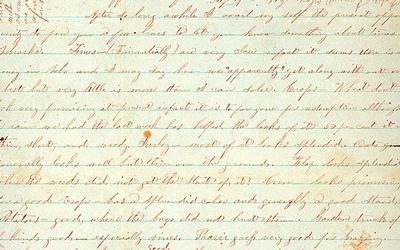
Description
The letter is from Giles S. Thomas to the Thomas family on July 23, 1876. Giles Thomas describes the condition of a large number of different crops he is growing on his farm in Nebraska. He also discusses the condition of several different types of livestock.
"The Crop Outlook" Newspaper Article, June 30, 1906
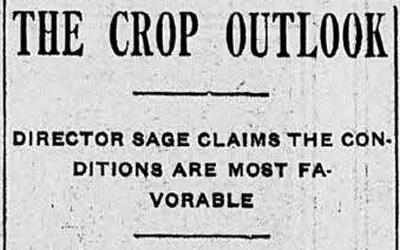
Description
This article is from the Ottumwa Tri-Weekly Courier and was published June 30, 1906. It is about a report filed by the director of Agriculture in Iowa, J.R. Sage. The report speaks of the welcomed rain all of Iowa received the previous week, and gives an update on…
"1913 Farm Crops and their Value" Newspaper Article, May 14, 1914
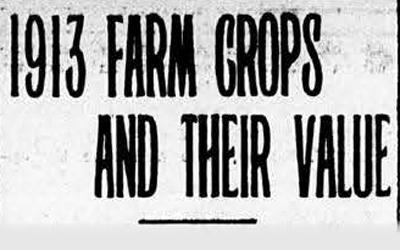
Description
This 1914 newspaper article is from the Evening Times-Republican in Marshalltown, Iowa. The article has a table that shows many varieties of crops that are grown in Iowa, and it also discusses the yield and values of each of these common farm commodities.
Farm Family in the United States, between 1915 and 1923

Description
The image shows a farm family that is tending to their crops on their farm sometime around 1915. There are several different crops being grown that can be seen in the photograph.
Stacks of Sugarcane in Emmet County, Iowa, December 1936

Description
The photograph shows several stacks of sugarcane that are being grown in Emmet County, Iowa, in 1936. The sugarcane stacks are wide at the base and get narrow at the top. They dominate the picture. There is a partial image of a house on the far-left side of the picture…
USDA Crop Production 2015 Summary, January 2016
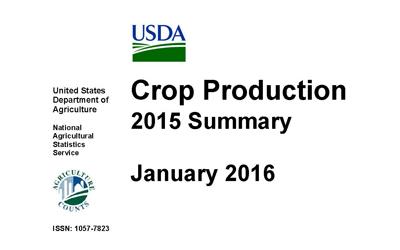
Description
The U.S. Department of Agriculture report is an annual assessment put out by the federal government. This 2016 edition lists the amount of land planted and harvested for a variety of crops in individual states and across the entire country. The crops included in this…
Lush Soybean Field on Dean and Julie Folkmann's Hog Farm in Newhall, Iowa, August 8, 2016

Description
The image shows the farmstead of Folkmann family in Benton County, Iowa. As of 2016, the Folkmann hog farm has been in the family for 162 years. At any time, approximately 50 million hogs are being raised in the state with just over 3 million people. That's about one-third…
Rolling Country Road and Crops in Benton County, Iowa, August 8, 2016
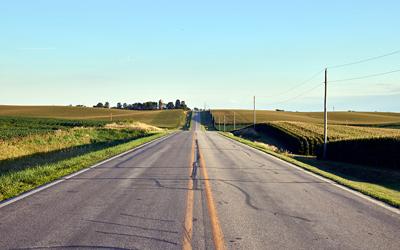
Description
The photograph is of a country road through Benton County, Iowa, in August of 2016. On both sides of the road are fields of corn, which appears to be the only crop being grown for miles. Benton County is on the eastern side of the state, near towns and cities such as…
Soviet Premier Nikita Khrushchev Visits Farms, Research Center in Iowa, 1959
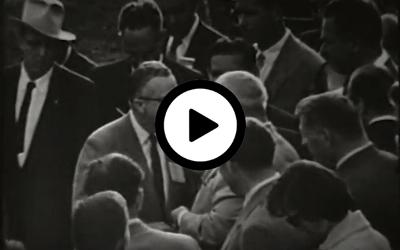
Description
This film shows the news footage of Soviet Premier Nikita Khrushchev's visit to Iowa in 1959. Film five focuses on Khrushchev at the Iowa State University Swine Nutrition Farm. It shows him seeing how hogs were raised from birth to market.
Soviet Premier Nikita Khrushchev Visits Iowa, September 23, 1959

Description
Russian Premiere Nikita Khrushchev is seen in this photo in a motorcade traveling down Keosauqua Way en route to a reception at Hotel Ft. Des Moines. Khrushchev also was in Coon Rapids, Iowa, earlier on September 23, 1959, as he visited Garst farms and was hosted…
Iowa Hog Lift to Japan, 1960

Description
The image shows hogs from Iowa being taken off a plane in Yamanashi Prefecture in Japan. The hogs were sent as a goodwill offering the province in Japan in January of 1960. In 1959, this area of Japan experienced two destructive and catastrophic typhoons. There were 36 hogs…
"Food for Freedom" Church Women United Letter, 1966
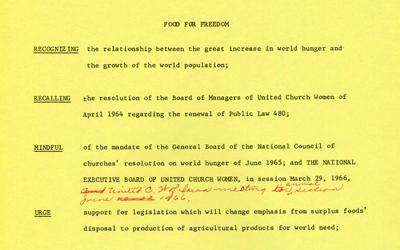
Description
This typed letter from the Church Women United in Des Moines encourages support of legislation to produce agricultural products for world relief. The resolution supports legislation to "change emphasis from surplus foods' disposal to production of agricultural products for…
"An Essay on the 80’s Des Moines: A World Food Center for the Nation," November 26, 1982
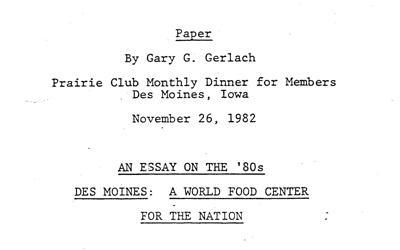
Description
This paper was written by Gary G. Gerlach and was presented at a meeting of the Prairie Club of Greater Des Moines. In this letter, Gerlach described the success of agriculture and advancements in Iowa. He outlined the monetary value of Iowa’s two main cash crops, corn and…
S.2250: Congressional Tribute to Dr. Norman E. Borlaug Act of 2006, December 14, 2006
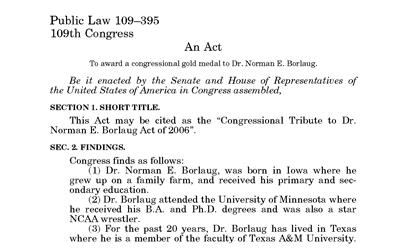
Description
The United States Congress, based on a resolution by Sen. Charles Grassley, recognized the achievements of Iowan Norman Borlaug for his efforts to feed the world with his breakthroughs on crops that are drought and disease resistant. The U.S. Congress issued the…
"Vilsack Commemorates 50th Anniversary of the Iowa 'Hog Lift' in Yamanashi" Article, April 8, 2010
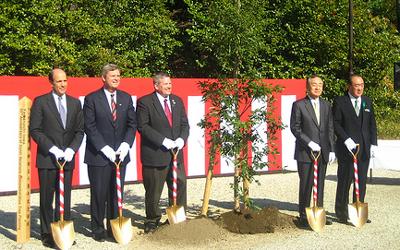
Description
The article released by the U.S. Department of Agriculture highlights events of the 50th anniversary of the Iowa "hog lift" in Japan. Then-U.S. Secretary of Agriculture, Tom Vilsack, visited Japan in honor of the famous hog lift of 1960, which was a rescue effort by the…
"Diplomatic Farmers: Iowans and the 1955 Agricultural Delegation to the Soviet Union," 2013
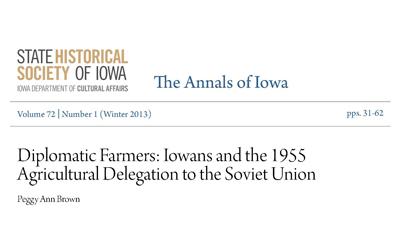
Description
From The Annals of Iowa, this source describes the process for selecting a unique delegation of men to travel to the Soviet Union from America, with a large number of delegates coming from Iowa. They describe the sites they saw and offered advice and…
Additional Resource:
- Living History Farms Learning Fields
This web exhibit offers lesson plans about Iowa agriculture and additional resources to use in the classroom about the harvesting of crops and livestock in the state.
Iowa Core Social Studies Standards (7th Grade)
Listed below are the Iowa Core Social Studies content anchor standards that are best reflected in this source set. The content standards applied to this set are middle school-age level and encompass the key disciplines that make up social studies for seventh grade students.
| No. | Standard Description |
| SS.7.13. | Identify social, political, and economic factors that can influence our thoughts and behavior. |
| SS.7.24. | Analyze connections among historical events and developments in contemporary global issues. |